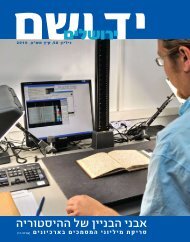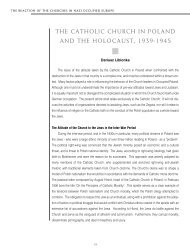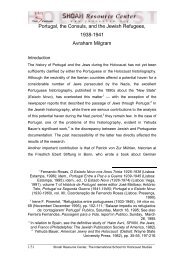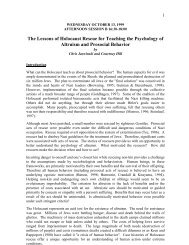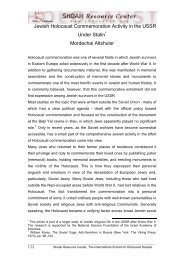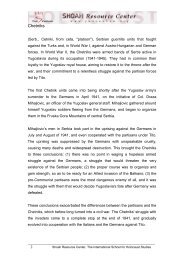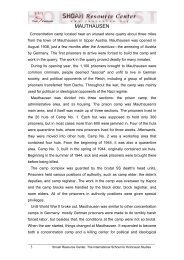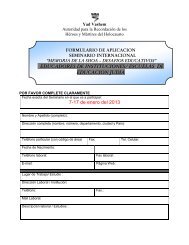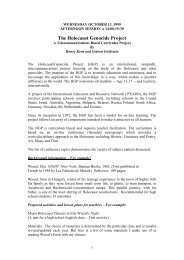Magazine 48 - Winter 2008 - Yad Vashem
Magazine 48 - Winter 2008 - Yad Vashem
Magazine 48 - Winter 2008 - Yad Vashem
Create successful ePaper yourself
Turn your PDF publications into a flip-book with our unique Google optimized e-Paper software.
Visual Center<br />
“by Liat Benhabib<br />
Watching my movie gave them the courage to look into their connections<br />
to the Nazi horrors. No German can escape this; it’s an inseparable part<br />
of our society.” Film director Malte Ludin, Germany<br />
Hans Ludin was no ordinary German soldier, but the story of his family<br />
is typical. Hans’ son Malte was five years old when his father was executed in<br />
1947 for war crimes. In his film, 2 or 3 Things I Know About Him (85 min.,<br />
Germany, 2005), Malte Ludin attempts to confront the family’s memory and<br />
especially his father’s smiling image, through testimony and archival materials.<br />
“For years, I struggled with myself. I knew that my mother wouldn’t agree<br />
to the film, and I was aware of my sisters’ stance, though I didn’t imagine how<br />
extreme it could be. But I’m a filmmaker: making films is my way of<br />
understanding the world and myself,” said Ludin in a telephone interview<br />
from Berlin.<br />
“<br />
2 or 3 Things<br />
I Know About Him”<br />
Hans Ludin, an enthusiastic National Socialist,<br />
joined the ranks of the SA in the 1920s. In 1941,<br />
he was appointed Nazi Germany’s ambassador to<br />
Slovakia, and moved his family to Bratislava. Ludin<br />
personally signed the deportation orders for<br />
approximately 70,000 Slovak Jews, thus taking part<br />
in their murder.<br />
After his mother’s death, Malte opened a chest<br />
in the attic containing the family legacy: newspaper<br />
clippings, letters, photographs and documents<br />
belonging to Hans, all of which present an entirely different picture from the<br />
one his sisters clung to so desperately. Ludin had interviewed his mother before<br />
her death, and later approached his sisters with great sensitivity and patience.<br />
News from the Visual Center by Liat Benhabib and Mimi Ash<br />
Cinema as a Site of Memory<br />
“<br />
Cinema as a Site of Memory” was the topic of a conference on 3<br />
December jointly sponsored by the Visual Center at <strong>Yad</strong> <strong>Vashem</strong> and<br />
the Jerusalem Cinematheque. The conference, held as part of the ninth<br />
Jewish Film Festival, in honor of the tenth anniversary of the<br />
Cinematheque’s Joan Sourasky-Constantiner Holocaust Multimedia Research<br />
Center, examined film as a major influence on individual and collective memory.<br />
Dr. Gideon Ofrat opened the conference with a philosophical perspective<br />
on perception and memory as expressed in Holocaust-related film. <strong>Yad</strong> <strong>Vashem</strong><br />
Chairman Avner Shalev explained the curatorial vision behind the films and<br />
other media featured in the permanent exhibit of <strong>Yad</strong> <strong>Vashem</strong>’s Holocaust<br />
History Museum. Video artist Michal Rovner presented her ideas on the<br />
relationship between form and content in her work at the museum’s entrance<br />
“Living Landscape,” and producer/director Noemy Schory delineated the<br />
process behind the production of the 110 historical films in the museum. Dr.<br />
Daniel Uziel and Dr. Yvonne Koslovsky-Golan surveyed films of various genres,<br />
from Nazi propaganda and documentation to later documentaries.<br />
Additional speakers were Piotr Cywinski, Director of the Auschwitz-<br />
Birkenau Museum, and Robert Thalheim, director of the feature film, And<br />
Along Came the Tourists (Germany, 2007), which was screened at the end of<br />
the conference and followed by a discussion about the significance of using<br />
Despite this, when he confronted his older sister Barbel with the bitter truth<br />
about their father, she stopped speaking to him. Ellen, his other sister, reveals<br />
the pain of recognition of her father’s crimes: “In my mind, I understand that<br />
I am the daughter of a perpetrator, but this is not what I feel my in my heart.”<br />
However, Ludin does not let up. In a particularly jarring sequence, he<br />
juxtaposes his sisters’ innocent childhood memories with close-ups of the<br />
document calling for the deportation of the Jews of Slovakia signed by his father,<br />
cutting to the testimony of a member of the Stern family who had been the<br />
Ludins’ neighbors until the “cleansing orders.” Ludin interviews Holocaust<br />
survivors, including Israeli poet Tuvia Rübner, the only member of his family<br />
to survive.<br />
Ludin’s film is a powerful personal testimony, as well as a reflection upon<br />
responsibility, memory and historical truth. “I am not naïve, a movie can’t<br />
change the world,” he admits. “However, at every screening I held in Germany,<br />
at least one or two people stood up to say that they identified with my stance<br />
in the film of being the ‘black sheep’ in the family; and that watching my movie<br />
gave them the courage to look into their connections to the Nazi horrors. No<br />
German can escape this; it’s an inseparable part of our society. German youth<br />
have many reminders of the Holocaust—memorials, days of remembrance—but<br />
I believe that knowing and understanding what happened is not enough. There<br />
has to be something else, something connected to the emotions. In my opinion,<br />
encouraging Holocaust awareness has to be accomplished through the heart<br />
as well.”<br />
Malte Ludin and his wife Iva Svarcová, the film’s producer and a native<br />
of Slovakia, will screen 2 or 3 Things I Know About Him in Israel to mark<br />
International Holocaust Remembrance Day. The film will be shown at the Tel<br />
Aviv Cinematheque on 27 January <strong>2008</strong>, and at <strong>Yad</strong> <strong>Vashem</strong>’s Visual Center<br />
and the Jerusalem Cinematheque the following day. The Goethe Institute, the<br />
Israeli German Society (IDG) and the Remembrance & Future Fund Germany<br />
are sponsoring Ludin and Svarcová’s visit.<br />
“For a long time, making this film was hard for me, but it burned within<br />
me,” concludes Ludin. “It has already been screened in many countries, but<br />
the warmest and most empathetic reactions have come particularly from Jewish<br />
and Israeli audiences.”<br />
Auschwitz as a film location. And Along Came the Tourists tells the story of<br />
Sven, a young German, who ends up at the Auschwitz museum in the course<br />
of his national service. Like Sven, the audience encounters the historical place<br />
and the present site of commemoration, the people who continue to visit, and<br />
those who are no longer with us.<br />
New Collections of Rare Films<br />
T<br />
he Visual Center recently acquired 34 films from DEFA (Deutsche<br />
Film Aktiengesellschaft), the official East German film production<br />
company from 1946-1992. Although DEFA’s over 7,500 films<br />
exhibit depth, variety and a daring attempt to test the limits of<br />
censorship, they remain largely unknown among film enthusiasts worldwide.<br />
The Visual Center participated in the recent “Black + White ≠ Grey” DEFA<br />
Retrospective in Israel, which featured Academy-Award nominee Jakob der<br />
Lügner (Frank Beyer, 1975), The Murderers are Among Us (Wolfgang Staudte,<br />
1946) and The Second Track (Joachim Kunert, 1962).<br />
Five films produced by the Michlalah Jerusalem Womens’ College featuring<br />
rare survivor testimonies by Orthodox Jews concerning issues of religious<br />
observance have also been added to the Visual Center’s film collection.<br />
Liat Benhabib is Director of <strong>Yad</strong> <strong>Vashem</strong>’s Visual Center, and Mimi Ash is Acquisitions and Projects<br />
Coordinator at the Visual Center.



